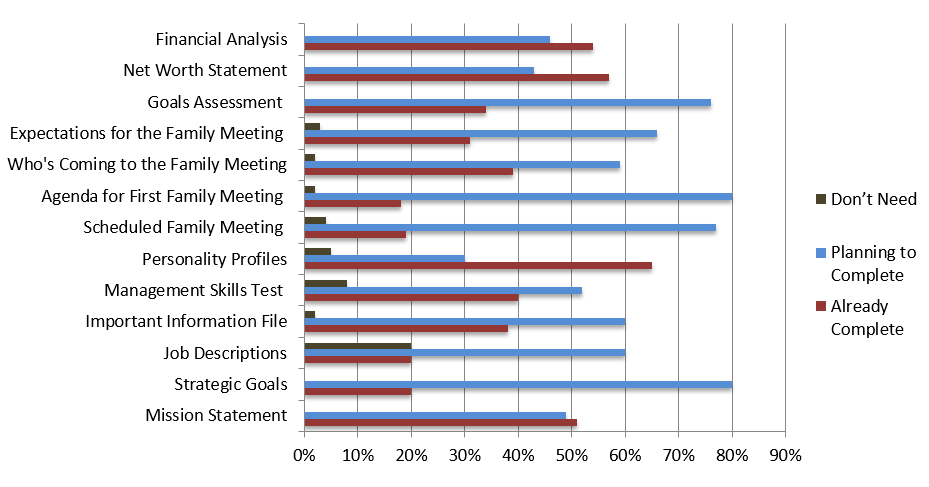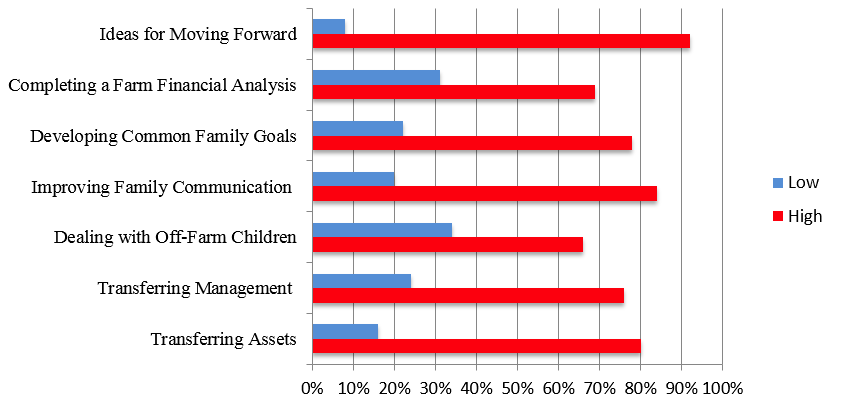 |
August 2017
|
August 2017 // Volume 55 // Number 4 // Ideas at Work // v55-4iw5
Multiyear Succession and Estate Planning for Farm and Ranch Families
Abstract
Farm succession and estate planning pose difficult challenges for farmers. Idaho farmers generally do not have a business succession plan or an estate plan. Due to the complexities of farm management, University of Idaho Extension personnel partnered with the Idaho Barley Commission and the U.S. Department of Agriculture Risk Management Agency to develop a novel multiyear educational program. This program focused on introducing farm families to succession, retirement planning, and tax management strategies and motivating them to build and implement relevant plans. Findings indicate that participants increased their knowledge of succession and estate planning and completed and implemented major aspects of their management plans.
Introduction
Estate planning and farm succession are processes farmers often avoid because they involve difficult issues related to people, property, taxes, and laws (Heleba, Parsons, & Sciabarrasi, 2004). However, having a plan can be vital in reducing uncertainty and family stress.
The average age of U.S. principal farm operators was 58.3 years in 2012, up 2% from 57.1 in 2007 (U.S. Department of Agriculture, 2014a). But the number of farm operators who were over 65 years of age decreased by 22% from 2007 to 2012, and the number of farm operators who were under 45 years of age increased by 32% (U.S. Department of Agriculture, 2014b). A survey conducted by researchers at the Beginning Farmer Center at Iowa State University showed that 60% of Iowa farmers did not have an estate plan and that only 27% had identified a successor (Duffy, Baker, & Lamberti, 2006). Similar results were found with Minnesota farm families (Hachfeld et al., 2009). Consequently, farm succession, retirement, and planning education have become high-priority topics for Extension educators (O'Neill, Komar, Brumfield, & Mickel, 2010).
Results of needs assessments in Idaho, including feedback from farm families, commodity associations, lenders, accountants, and attorneys who work for farm families, have strongly supported Extension programming in these areas.
Program Purpose and Methods
As the University of Idaho farm succession team, we responded to this need for programming by partnering with the Idaho Barley Commission and the U.S. Department of Agriculture Risk Management Agency to develop and implement a three-phase program offered in southern Idaho. The main objective of the program was to help producers initiate dialogue with family members and learn about tools and options for developing their own estate plans. The program was organized around three components that are considered to be the three legs of an estate plan: (a) succession plan, (b) retirement plan, and (c) tax management plan. The resources used to develop the program are listed in the appendix.
The workshops were delivered over a 3-year period as described here.
- Year 1: One-day workshops covered the basics of farm succession and estate planning and were designed to motivate participants to begin the process. Topics included development of a mission statement and goals, completion of a personality profile assessment, development of a resource inventory, discussion of the 10 rules for transition, and owner/employee compensation. The program also included a guest speaker, such as an attorney or estate planning professional, who discussed estate-planning tools such as wills, trusts, business structures, and asset transfer.
- Year 2: A 4-week program (1 day per week) covered similar topics as described above, but in greater detail. Again, guest speakers presented pertinent information. An accountant discussed estate taxes, capital gains taxes, gifting, business structures, and a tax management plan. A financial planner spoke about retirement planning, insurance, investments, and annuities. An attorney explained trusts, wills, probate, and business structures. In the final segment, students participated in role-playing family meetings.
- Year 3: A 1-day program was developed at the request of participants to help keep farm families motivated and moving forward with their plans. This workshop began with a report from each family on the challenges and opportunities experienced during the preceding year. Topics included real estate transfer strategies and two-generation farming.
Evaluation Results
In 3 years, more than 160 producers participated in one or more of the Farm Succession and Estate Planning workshops in 13 locations. Written evaluations completed by participants at the end of each program yielded the following information:
- 100% of participants planned to begin or had begun the estate planning and farm succession process.
- 97% of participants planned to put together a team (accountant, lawyer, financial planner, etc.) to assist them with estate planning.
As part of the evaluation, participants were asked which of the estate planning objectives they were planning to complete or had completed. Results are summarized in Figure 1.
Figure 1.
Multiyear Farm and Ranch Succession and Estate Planning Program Participants' Progress on Steps for Completing an Estate Plan

Participants also were asked to evaluate the amount of knowledge they gained through class attendance. Results are summarized in Figure 2.
Figure 2.
Knowledge Gained by Participants in Multiyear Farm and Ranch Succession and Estate Planning Program

Key Points for Successful Estate Planning Education
Through implementing the program and analyzing participants' written evaluations, we identified approaches that are most likely to bring about changes in behavior and motivate farm and ranch families to build and implement viable estate plans. Our insights and observations are as follows:
- Participants learn from each other, regarding both successes and failures. Discussions among participants create some of the most valuable teaching and learning opportunities.
- The longer participants wait to make necessary plans, the fewer options they have.
- Situations are similar. Each producer thinks his or her situation is unique, but as producers talk with one another, they realize their challenges are similar, even though they may require differing strategies to resolve them.
- Relationships are the main challenge facing farm families. Participants often pointed out that many programs teach management and planning strategies, but few focus on communication and family dynamics. Treating family members fairly and equally, dealing with off-farm heirs, and addressing in-law relationships are often the largest obstacles farm families face when building estate plans.
References
Duffy, M. D., Baker, J., & Lamberti, A. (2006). Iowa farmers' business and transfer plans. Retrieved from http://www.extension.iastate.edu/
Hachfeld, G. A., Bau, D. B., Holcomb, C. R., Kurtz, J. N., Craig, J. W., & Olson, K. D. (2009). Farm transition and estate planning: Farmers' evaluations and behavioral changes due to attending workshops. Journal of Extension, 47(2), Article 2FEA8. Available at: http://www.joe.org/joe/2009april/a8.php
Heleba, D., Parsons, R., & Sciabarrasi, M. (2004). Minimizing farm business succession risk in New England: Delivery of Transferring the Farm workshops. Journal of Extension, 42(6), Article 6RIB6. Available at: http://www.joe.org/joe/2004december/rb6.php
O'Neill, B., Komar, S., Brumfield, R., & Mickel, R. (2010). Later life farming: Retirement plans and concerns of farm families. Journal of Extension, 48(4), Article 4FEA6. Available at: http://www.joe.org/joe/2010august/a6.php
U.S. Department of Agriculture. (2014a). 2012 Census of agriculture: Demographics. Washington, DC: Author. Retrieved from http://www.agcensus.usda.gov/Publications/2012/Online_Resources/Highlights/Farm_Demographics/Highlights_Farm_Demographics.pdf
U.S. Department of Agriculture. (2014b). 2012 Census of agriculture: Summary by age and primary occupation of principal operator. Washington, DC: Author. Retrieved from http://www.agcensus.usda.gov/Publications/2012/Full_Report/Volume_1,_Chapter_1_US/st99_1_069_069.pdf
Appendix: Resources Used to Develop Multiyear Succession and Estate Planning Program for Farm and Ranch Families
- Passing It On: An Estate Planning Resource Guide for Wyoming's Farmers and Ranchers, by L. Pauley, A. Schroeder, C. Ehmke, and C. Paseneaux, 2011, University of Wyoming Extension. Retrieved from http://www.uwyo.edu/
- Checking Your Farm Business Management Skills, by M. Boehlje, C. Dobbins, A. Miller, J. Bechman, and A. Rausch, 2000, Purdue University Extension, ID-237. Retrieved from https://www.extension.purdue.edu/
- Developing Effective Job Descriptions for Small Businesses and Farms, by C. Dobbins and C. Ehmke, 2005, Purdue University Extension, EC-728. Retrieved from https://www.extension.purdue.edu/
- The Color Code Personality Assessment, by T. Hartman, 2007. Retrieved from http://www.colorcode.com/
- Two-Generation Farming, Step 1: Getting Started, by D. Hofstrand, 1998, Iowa State University Extension, Pm-147a. Retrieved from https://store.extension.iastate.edu/
- Two-Generation Farming, Step 2: Selecting a Business Arrangement, by D. Hofstrand, 1998, Iowa State University Extension, Pm-147b. Retrieved from https://store.extension.iastate.edu/
- Two-Generation Farming, Step 3: Making It Work, by D. Hofstrand, 1998, Iowa State University Extension, Pm-147c. Retrieved from https://store.extension.iastate.edu/
- Farm Finance Scorecard, by K. Becker, D. Kauppila, G. Rogers, R. Parsons, D. Nordquist, and R. Craven, 2009, University of Vermont Extension and the Center for Farm Financial Management, University of Minnesota. Retrieved from http://www.cffm.umn.edu/
- Evaluating Your Estate Plan: Retirement Planning for Farm Families, by T. Eggers, 2012, Iowa State University Extension and Outreach, C4-56. Retrieved from http://www.extension.iastate.edu/
- Selecting an Organizational Structure for Your Business, by J. Schumacher and M. Goetting, 2008, Montana State University Extension, MT199708HR. Retrieved from http://msuextension.org/
- "Some Do's and Don'ts for Successful Farm and Ranch Family Estate Transfers," by R. F. Fetsch, 1999, Journal of Extension, 37(3), Article 3IAW2. Available at: http://www.joe.org/joe/1999june/iw2.php




